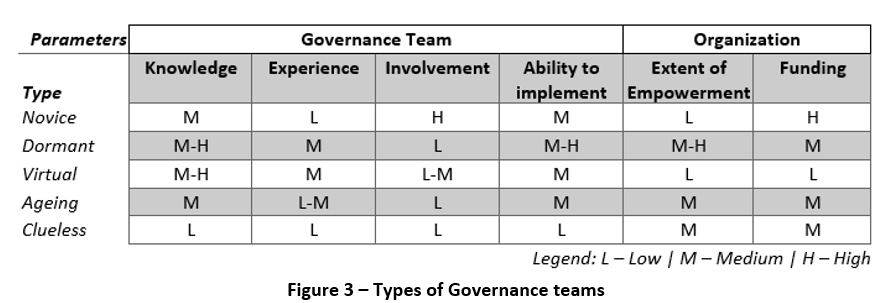Click to learn more about author Jayakumar Rajaretnam.
This is the second part of a two-part series on the operationalization of Data Governance. The first part of the series “Data Governance Operationalization: The Gap” discussed how the need arose, some of the main reasons needed for Data Governance operationalization, and what is required. This part takes a deeper view of building a Data Governance team, what a successful operation looks like, and some key takeaways.
A Critical Component: The In-house Governance Team
Data Governance is a combination of people, process and technology. Of the three components, the People component can contribute 40-50% towards the extent and success of operationalization. Hence, a good understanding of the in-house governance team type is critical. Except for a few organizations where the governance team has matured with an operational governance structure, the governance team in other organizations invariably falls into one of the five types below:
- Novice team: This team understands the governance concepts and confident of implementing it, but lacks the practical implementation experience. Mostly comprises of a high-energy team who finds time for governance initiatives. Unfortunately, the team lacks empowerment to establish the governance practice. This could either be due to trust issues or waiting to hire a senior officer (e.g., CDO) to take it forward. Funding is not a major concern.
- Dormant team: This team is mostly comprised of a few senior stakeholders who are aware of governance concepts and know what it takes to setup and operationalize governance at business unit or enterprise level. But due to the lack of top management push for governance, a reactive governance state is maintained. Funding and empowerment is not a concern in this type.
- Virtual team: A team formed by pulling subject matter experts from multiple projects to contribute to governance-related efforts, mostly on a part-time basis. This is common where functions within the organization realize the need for governance, but there is no funding and top management buy-in at the enterprise level. The objective is to keep governance moving until a trigger happens. As this is a virtual organization, enforcement of governance policies across the organization suffers.
- Aging team: The average age of this team is high and their interest level to pick up governance and implement it is low. Resistance to governance initiatives will be clearly visible as it is seen as something that will increase their workload for no return.
- Clueless team: The maturity of the stakeholders in this team is very low in terms of governance concepts. Primary reasons are lack of training and direction from top management to kick-start governance. Having said that, it is critical to find out how this team was formed as it can sometimes change the dynamics of the recommendation/solution.
Each of the above types requires a different operationalization strategy. Post the governance type identification, organizational change management (OCM) can be leveraged to operationalize governance. For example, novice team requires empowerment, the virtual team requires physicalization, the clueless team requires training and/or onboarding an experienced governance officer to guide the team forward.
Where is Data Governance Successfully Operational?
Organizations where governance is baked into the culture of the organization and organizations that identify themselves as “data companies” have an operational Data Governance setup at enterprise level. In heavily regulated industries like banking and financial services, healthcare and life science, the heavy penalties seem to play a critical role in waking up the senior leadership, to invest and relook at their Data Strategy to keep governance around data healthy to avoid these fines year after year.
In the moderately regulated sectors like retail the need for 360 view of customer is prompting companies to operationalize Data Governance. In industries like Energy & Utilities and manufacturing, the need for quick turn-around, optimization and efficiency is driving the Data Governance agenda.
The Gap
According to the Quality Axiom,
- “What cannot be defined cannot be measured;
- What cannot be measured cannot be improved, and
- What cannot be improved will eventually deteriorate.”
This is very true in governance also. Top management wants to see something tangible every 3 months. In other words, Return on Investment (ROI) for every dollar spent. So if there is no clarity in terms of how to show the benefits of DG, operationalization would be a distant dream.
The best ways to tackle this is to start small, pick the right project, scope and metrics for every milestone. To elaborate, pick one governance area at a time say, data quality or metadata and expand as you show value and progress. This will help keep the costs down, accommodate changing priorities and be flexible to technology disruptions.
Key Takeaway
The step between strategy definition and implementation is critical to successfully operationalize governance. Most of the elaborate strategy definitions include a maturity assessment of people, process and technology components. In addition, they provide some insights into the change impact based on the potential in-house team identified. If either of this is not available, this should be the first step. A close look at the maturity and change impact index should give a high-level view into what could potentially hinder operationalization in your organization. Once the possible blocker(s) for governance is identified, it is easy to address them one by one.
Survey Methodology
The survey included studying 19 organizations spread across Banking and Financial services, Insurance, Healthcare, Energy & Utilities, Retail, Technology, Communication and Manufacturing domains. The organizations were at various levels of maturity and implementation progress. Mode of analysis: Combination of survey and interaction with subject matter experts close to data management at the respective client locations.

